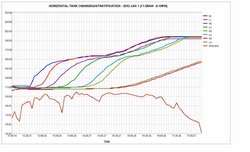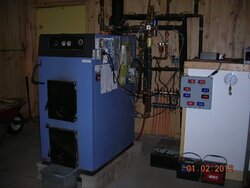Since I haven't done this for awhile, a January 1, 2012, burn is a good time to log some data and show what happens during a gasser burn while charging 1050 gallons of horizontal, pressurized storage, with boiler and insulated storage in the heated building space.
The burn started at 11:45AM, but due to my error data logging did not start until 11:55AM. Logging was every 5 minutes. 137 lbs of wood and kindling were burned. Assumed energy available at 20% MC and 400F stack temp is 6050 btu/lb. Storage start temp about 115F; storage end temp about 190F. Energy stored = (190-115) x 8.33 x 1050 = 656,000 btu's. Energy available = 137 x 6050 = 829,000. Efficiency to storage = 656,000 / 829,000 = 79%.
No draw on storage during burn (circs shut off); 6.5 hours of burn; shop interior temp maintained at 62F; approximate building heat loss (from other measurements) is about 12,000 btuh; heat from boiler burn and loss from tank to heat building = 12,000 x 6.5 = 78,000 btu's. Total efficiency = (656,000 + 78,000) / 829,000 = 89%. This might represent what could be expected in added efficiency and heat gain from locating a boiler and storage in a typical heated space rather than an out-building.
The tank has 8 sensors installed on the surface of the tank, 4 on each end of the tank at the top (R1 and L1), down 12" (R2 and L2), down 24" (R3 and L3), and at the bottom (R4 and L4). Tank sensors are DS18B20. Supply to the tank is into a horizontal port on the L end of the tank and 6" down from the top. Return from the tank is from a horizontal port on the L end of the tank and 6" up from the bottom. The tank has a minimum of R30 insulation. All plumbing has insulation.
The chart also shows stack temperature (divided by 4 to display on the same chart as the tank temperatures), as measured with a K-type sensor inserted into the center of the stack 12" above the elbow exiting from the boiler. Average stack temperature is approximately 400F.
This burn represents a very typical burn in my system, about 6 hours long. The burn will provide heat from storage to heat the building for about 48-56 hours before another burn will be needed. Typical winter burns are every other day.
I hope you find this interesting and helpful. Please ask questions. Happy New Year!
The burn started at 11:45AM, but due to my error data logging did not start until 11:55AM. Logging was every 5 minutes. 137 lbs of wood and kindling were burned. Assumed energy available at 20% MC and 400F stack temp is 6050 btu/lb. Storage start temp about 115F; storage end temp about 190F. Energy stored = (190-115) x 8.33 x 1050 = 656,000 btu's. Energy available = 137 x 6050 = 829,000. Efficiency to storage = 656,000 / 829,000 = 79%.
No draw on storage during burn (circs shut off); 6.5 hours of burn; shop interior temp maintained at 62F; approximate building heat loss (from other measurements) is about 12,000 btuh; heat from boiler burn and loss from tank to heat building = 12,000 x 6.5 = 78,000 btu's. Total efficiency = (656,000 + 78,000) / 829,000 = 89%. This might represent what could be expected in added efficiency and heat gain from locating a boiler and storage in a typical heated space rather than an out-building.
The tank has 8 sensors installed on the surface of the tank, 4 on each end of the tank at the top (R1 and L1), down 12" (R2 and L2), down 24" (R3 and L3), and at the bottom (R4 and L4). Tank sensors are DS18B20. Supply to the tank is into a horizontal port on the L end of the tank and 6" down from the top. Return from the tank is from a horizontal port on the L end of the tank and 6" up from the bottom. The tank has a minimum of R30 insulation. All plumbing has insulation.
The chart also shows stack temperature (divided by 4 to display on the same chart as the tank temperatures), as measured with a K-type sensor inserted into the center of the stack 12" above the elbow exiting from the boiler. Average stack temperature is approximately 400F.
This burn represents a very typical burn in my system, about 6 hours long. The burn will provide heat from storage to heat the building for about 48-56 hours before another burn will be needed. Typical winter burns are every other day.
I hope you find this interesting and helpful. Please ask questions. Happy New Year!



